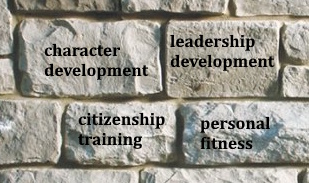The Scouts BSA program has four aims.

Scouting America has defined eight methods to be used to achieve those aims.
1. Ideals
The ideals of Scouting are spelled out in the Scout Oath, the Scout Law, the Scout motto, and the Scout slogan. The Scout measures themselves against these ideals and continually tries to improve.
2. Patrol Method
Patrols are small groups of Scouts who camp together, cook together, play together, and learn together. Patrols are where Scouts learn citizenship at the most basic level. They also take on responsibilities within the patrol, and learn teamwork and leadership. Patrols are like Cub Scout dens but with one big difference: Patrols elect their own leaders, and through these patrol leaders, Scouts have a voice in deciding what activities the troop will put on its calendar. Patrols are one component of what we call a youth-led troop.
3. Outdoor Programs
Scouting is designed to take place outdoors. It is the arena where Scout skills are put into practice. Out in nature, away from technology and man-made artifice, the Scouts learn self-reliance, perseverance, and the importance of their relationships with their fellow Scouts. Kids are not going to immediately enjoy camping and campfire cooking, so we camp every month in order to normalize this method of Scouting.
4. Advancement
Scouting has a system of ranks in which Scouts learn progressively more difficult skills and take on progressively greater responsibilities. The highest of these ranks is Eagle Scout, and becoming an Eagle Scout is a huge accomplishment that your child can be proud of their entire life. But there is much more to advancement than becoming an Eagle Scout, and advancement is only one of eight methods for achieving the purposes of Scouts BSA. Our approach to advancement is one of moderation: we do not pressure Scouts to advance, but we encourage them to do so.
5. Associations With Adults
As children become teenagers, they reach out for new role models. Scouting America recognizes the importance of providing youth with vetted, trained adults who can provide guidance. In many cases, a Scoutmaster, a merit badge counselor, or one of the troop parents who is willing to listen to scouts, encourage them, and take a sincere interest in them can make a profound difference in their lives. Adult association is also part of what we call a youth-led troop. Adults understand that their role is to create a safe place where scouts can learn and grow and explore and play and take on responsibilities—and fail, and get up and try again.
6. Personal Growth
As Scouts plan their activities and progress toward their goals, they experience personal growth. Scouts grow as they participate in community service projects and do Good Turns for others. Through our charter organization and the requirements of Scouting America, we provide many opportunities for giving back to the community. Frequent personal conferences with the Scoutmaster helps each Scout to determine his growth toward Scouting’s aims.
7. Leadership Development
The Scout program encourages scouts to learn and practice leadership skills. Every Scout has the opportunity to lead in some way, and we provide training and feedback for those leaders to develop their skills. Leadership development is a requirement for a youth-led troop.
8. Uniform
Like sports teams, Scouts wear a uniform. Like most sports teams, we expect our Scouts to wear the uniform when they are doing Scouting, and to wear it properly. It is a symbol of who we are and what we have accomplished. The effect of a uniform on an individual and on a group cannot be overstated. No, we do not stay in uniform during our campouts, but we do travel in uniform. Anyone who doubts the positive impact of our uniform should see the reactions that we get when 30+ uniformed adults and youth are eating at Dairy Queen after a campout.